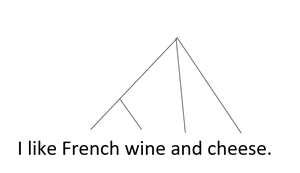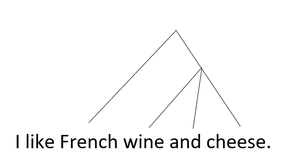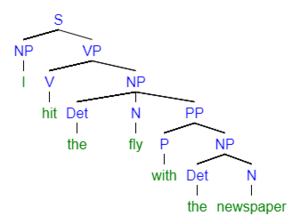User:MMuth: Difference between revisions
No edit summary |
No edit summary |
||
| Line 6: | Line 6: | ||
<div class="toccolours mw-collapsible mw-collapsed" style="width: | <div class="toccolours mw-collapsible mw-collapsed" style="width:700px"> | ||
Check for video transcript here: | Check for video transcript here: | ||
<div class="mw-collapsible-content"> | <div class="mw-collapsible-content"> | ||
| Line 28: | Line 28: | ||
Example: I like French wine and cheese. | Example: I like French wine and cheese. | ||
<br> | |||
Video file too big! | Video file too big! | ||
</br> | |||
<div class="toccolours mw-collapsible mw-collapsed" style="width: | <div class="toccolours mw-collapsible mw-collapsed" style="width:700px"> | ||
Check for video transcript here: | Check for video transcript here: | ||
<div class="mw-collapsible-content"> | <div class="mw-collapsible-content"> | ||
| Line 36: | Line 38: | ||
In this video I will look at one case of structural ambiguity. In this case one about coordination. | In this video I will look at one case of structural ambiguity. In this case one about coordination. | ||
Take the sentence “I like French wine and cheese.” as an example. This sentence could mean I like French wine and any kind of cheese. This would be the constituent structure, where French is a modifier of wine but not of cheese: | Take the sentence “I like French wine and cheese.” as an example. This sentence could mean I like French wine and any kind of cheese. This would be the constituent structure, where French is a modifier of wine but not of cheese: | ||
<br> | |||
[[File:Constituent structure .png| | [[File:Constituent structure .png|thumb]] | ||
</br> | |||
<br> | |||
The wine has to be French, but the cheese can come from any country. Or this sentence could mean I like French wine and French cheese. This would be the constituent structure where French is a modifier of both wine and cheese. | The wine has to be French, but the cheese can come from any country. Or this sentence could mean I like French wine and French cheese. This would be the constituent structure where French is a modifier of both wine and cheese. | ||
</br> | |||
<br> | |||
[[File:Constituent structure 2.png| | [[File:Constituent structure 2.png|thumb]] | ||
</br> | |||
<br> | |||
To test which reading is right you can do a constituent test with the conjunct. The sentence could then be I like French cheese and wine. Here the second reading that I like French wine and French cheese is still correct. However, the first reading that I like French wine and any cheese is not possible anymore. | To test which reading is right you can do a constituent test with the conjunct. The sentence could then be I like French cheese and wine. Here the second reading that I like French wine and French cheese is still correct. However, the first reading that I like French wine and any cheese is not possible anymore. | ||
Revision as of 16:43, 25 May 2021
Term paper: L3, FW 2.1, WiSe 20/21
Types of Ambiguity
video file to big!
Check for video transcript here:
It is important to understand what kinds of ambiguity exist in natural language because this will help us to determine the grammatical and contextual factors which allow us to communicate without being lost in ambiguity all the time. The following video will explain the five types of ambiguity.
First of all, let’s talk about Lexical ambiguity. Lexical ambiguity occurs when a sentence contains a word that has more than one meaning which can obscure the writer’s intent and confuse the reader. Let’s take, for example, the sentence: “I saw bats.”. This sentence could be interpreted in four different ways. Number one: I used a tool with a sharp blade to slice through baseball bats. Number two: I viewed some nocturnal flying mammals. Number three: I viewed baseball bats. Number four: I used a tool with a sharp blade to slice through nocturnal flying mammals.
Another type of ambiguity is structural ambiguity. Structural ambiguity occurs when the meaning of the component words can be combined in more than one way. In other words: One word order can be associated with two or more different meanings. For example, the sentence: “The chicken is ready to eat.”. This sentence either means the chicken is cooked and can be eaten now, or the chicken is ready to be fed.
Scope ambiguities arise when the scope of a part - or parts - of a sentence is unclear. The scope is an area over which activity, capacity, or influence extends. Quantifiers (words like every), negations, and adverbial or adjectival modifiers often give rise to scope ambiguities. A sentence with a scope ambiguity need not be structurally ambiguous. For example, the sentence: “Every man loves a woman.”. This sentence could either mean: for every man, there is some woman that he loves, or every man loves the same woman.
Collective-distributive ambiguity occurs with sentences containing plural expressions and can give rise to two interpretations, a collective reading and a distributive reading. For example, the sentence: “Two students carried a heavy backpack.”. In the collective reading, this sentence means that the two students carried one heavy backpack together. In the distributive reading, the two students carried each a heavy backpack.
Referential ambiguity occurs when a word or phrase, in the context of a particular sentence, could refer to two or more properties or things. It is sometimes clear from the context which meaning is intended, but not always. For example, the sentence: “John met Bill before he went to school.”. This sentence could either mean John met Bill before John went to school or John met Bill before Bill went to school. Remember the 5 types of ambiguity are lexical, structural, scope, collective-distributive, and referential ambiguity. Thanks for watching!
Structural Ambiguity
Example: I like French wine and cheese.
Video file too big!
Check for video transcript here:
Structural ambiguity occurs when the meaning of the component words can be combined in more than one way. In other words: One word order can be associated with two or more different syntactic structures. This can lead to two or more different readings.
In this video I will look at one case of structural ambiguity. In this case one about coordination.
Take the sentence “I like French wine and cheese.” as an example. This sentence could mean I like French wine and any kind of cheese. This would be the constituent structure, where French is a modifier of wine but not of cheese:
The wine has to be French, but the cheese can come from any country. Or this sentence could mean I like French wine and French cheese. This would be the constituent structure where French is a modifier of both wine and cheese.
To test which reading is right you can do a constituent test with the conjunct. The sentence could then be I like French cheese and wine. Here the second reading that I like French wine and French cheese is still correct. However, the first reading that I like French wine and any cheese is not possible anymore. For this first reading to be correct the sentence would have to be converted into I like cheese and French wine. Then it would be structurally clear that French only belongs to one conjunct and not the whole coordination.
Examples
After having watched the video, work on the following tasks.
Task 1 Identify the determiners in the following sentence.
(a) Juliet talked to some stranger at the party.
(b) Every Capulet is an enemy to some Montague.
(c) Many people in Verona are not happy about the Capulet-Montague feud.
Check your solutions here:
(a) some
(b) every, some
(c) many
Task 2 Identify the formula that corresponds to the translation of the sentence.
Task 3 The sentence: Some Tybalt loved some Montague. is translated into the formula
∃ y (montague1(y) : love2(tybalt,y).
Given this table, is the overall formula true or false? (Give a reason for your answer.)
Check your solutions here:
The formula is false, because there is no individual in our model for which both the restrictor and the scope are true.
Feel free to send feedback on this exercise to Manfred Sailer.


